ing.
himself to be “an Aztec angel.”
In “Star Quilt,” Roberta Hill
Much Chicano poetry is highly
Whiteman (1947- ), a member of the
personal, dealing with feelings and
Oneida tribe, imagines a multicul-
family or members of the communi-
tural future like a “star quilt, sewn
ty. Gary Soto (1952- ) writes out of
from dawn light,” while Leslie
the ancient tradition of honoring
Marmon Silko (1948- ), who is part
departed ancestors, but these
Laguna Pueblo, uses colloquial lan-
words, written in 1981, describe the
guage and traditional stories to
multicultural situation of Americans
fashion haunting, lyrical poems. In
today:
“In Cold Storm Light” (1981), Silko
achieves a haiku-like resonance:
A candle is lit for the dead
Two worlds ahead of us all
out of the thick ice sky
running swiftly
In the 1980s, Chicano poetry
pounding
achieved a new prominence, and
swirling above the treetops
works by Cervantes, Soto, and
The snow elk come,
Alberto Rios were widely antholo-
Moving, moving
gized.
white song
storm wind in the branches.
Native-American Poetry
Native Americans have written
Louise Erdrich (1954- ), like Silko
fine poetry, most likely because a
also a novelist, creates powerful
tradition of shamanistic song plays a
dramatic monologues that work like
LESLIE MARMON SILKO
vital role in their cultural heritage.
compressed dramas. They unspar-
Their work has excelled in vivid, liv-
ingly depict families coping with
ing evocations of the natural world,
alcoholism, unemployment, and
which become almost mystical at
Photo © Nancy Crampton
poverty on the Chippewa reservation.
92
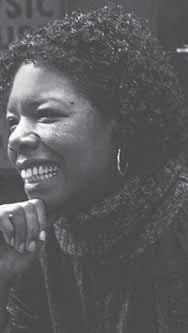
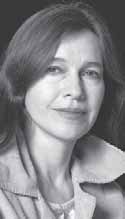
In Erdrich’s “Family Reunion”
Photo © David Ash /
Rita Dove (1952- ) was named
CORBIS OUTLINE
(1984), a drunken, abusive uncle
poet laureate of the United States
returns from years in the city. As he
for 1993-1995. Dove, a writer of
suffers from a heart disease, the
fiction and drama as well, won the
abused niece, who is the speaker,
1987 Pulitzer Prize for Thomas and
remembers how this uncle had
Beulah (1986), in which she cele-
killed a large turtle years before by
brates her grandparents through a
stuffing it with a firecracker. The
series of lyric poems. She has said
end of the poem links Uncle Ray
that she wrote the work to reveal
with the turtle he has victimized:
the rich inner lives of poor people.
Michael S. Harper (1938- ) has
LOUISE ERDRICH
Somehow we find our way back,
similarly written poems revealing
Uncle Ray
the complex lives of African
sings an old song to the body
Americans faced with discrimina-
that pulls him
tion and violence. His dense, allu-
toward home. The gray fins that
sive poems often deal with crowded,
his hands have become
dramatic scenes of war or urban
screw their bones in the
life. They make use of surgical
dashboard. His face
images in an attempt to heal. His
has the odd, calm patience of a
“Clan Meeting: Births and Nations: A
child who has always
Blood Song” (1971), which likens
let bad wounds alone, or a
cooking to surgery (“splicing the
creature that has lived
meats with fluids”), begins “we
for a long time underwater.
reconstruct lives in the intensive /
And the angels come
care unit, pieced together in a buf-
lowering their slings and litters.
fet.” The poem ends by splicing
together images of the hospital,
African-American Poetry
racism in the early American film
Black Americans have produced
Birth of a Nation, the Ku Klux Klan,
many poems of great beauty with a
film editing, and x-ray technology:
considerable range of themes and
tones. African-American literature
We reload our brains as the
is the most developed ethnic writing
cameras,
in America and is extremely diverse.
the film overexposed
Amiri Baraka (1934- ), the best-
in the x-ray light,
known African-American poet of the
locked with our double door
1960s and 1970s, has also written
light meters: race and sex
plays and taken an active role in pol-
spooled and rung in a hobby;
itics. The writings of Maya Angelou
we take our bundle and go
MAYA ANGELOU
(1928- ) encompass various literary
home.
forms, including poetry, drama, and
her well-known memoir, I Know Why
History, jazz, and popular culture
The Caged Bird Sings (1969).
Photo © Nancy Crampton
have inspired many African
93
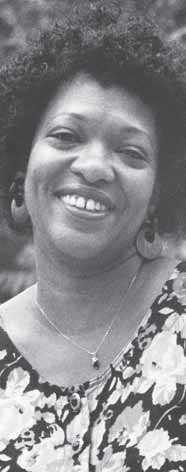
Americans, from Harper (a college
ditions — for example, comparing
professor) to West Coast publisher
the concepts of Tao and Logos.
and poet Ishmael Reed (1938- ),
Asian-American poets have drawn
known for spearheading multicultur-
on many sources, from Chinese
al writing through the Before
opera to Zen Buddhism, and Asian
Columbus Foundation and a series
literary traditions, particularly Zen,
of magazines such as Yardbird, Quilt,
have inspired numerous non-Asian
and Konch.
poets, as can be seen in the 1991
Many African-American poets,
anthology Beneath a Single Moon:
such as Audre Lorde (1934-1992),
Buddhism in Contemporary
have found nourishment in
American Poetry. Asian-American
Afrocentrism, which sees Africa as a
poets span a spectrum, from the
center of civilization since ancient
iconoclastic posture taken by Frank
times. In sensuous poems such as
Chin (1940- ), co-editor of Aiiieeeee!
“The Women of Dan Dance With
(an early anthology of Asian-
Swords in Their Hands To Mark the
American literature), to the gener-
Time When They Were Warriors”
ous use of tradition by writers such
(1978), she speaks as a woman war-
as Maxine Hong Kingston (1940- ).
rior of ancient Dahomey, “arming
Janice Mirikitani (1942- ), a sansei
whatever I touch” and “consuming”
(third-generation Japanese Ameri-
only “What is already dead.”
can), evokes Japanese-American
history and has edited several
Asian-American Poetry
anthologies, such as Third World
Like poetry by Chicano and Latino
Women (1973); Time To Greez!
writers, Asian-American poetry is
Incantations From the Third World
exceedingly varied. Americans of
(1975); and Ayumi: A Japanese
Japanese, Chinese, and Filipino
American Anthology (1980).
descent may often have lived in the
The lyrical Picture Bride (1983) of
United States for eight generations,
Chinese American Cathy Song
while Americans of Korean, Thai, and
(1955- ) also dramatizes history
Vietnamese heritage are likely to be
through the lives of her family. Many
RITA DOVE
fairly recent immigrants. Each group
Asian-American poets explore cul-
has grown out of a distinctive lin-
tural diversity. In Song’s “The
guistic, historical, and cultural tradi-
Vegetable Air” (1988), a shabby town
tion.
with cows in the plaza, a Chinese
Developments in Asian-American
restaurant, and a Coca-Cola sign
literature have included an empha-
hung askew becomes an emblem of
sis on the Pacific Rim and women’s
rootless multicultural contemporary
writing. Asian Americans generally
life made bearable by art, in this
have resisted the common stereo-
case an opera on cassette:
types as the “exotic” or “good”
minority. Aestheticians have com-
then the familiar aria,
Photo © Christopher Felver /
pared Asian and Western literary tra-
CORBIS
rising like the moon,
94
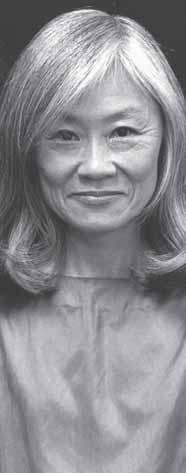
lifts you out of yourself,
transcendence, categories of genre
transporting you to another country
and canonical texts or accepted liter-
where, for a moment, you travel
ary works. Instead they propose
light.
open forms and multicultural texts.
They appropriate images from popu-
THE LANGUAGE SCHOOL,
lar culture and the media, and
EXPERIMENTATION, AND
refashion them. Like performance
NEW FORMALISM
poetry, language poems often resist
At the end of the 20th century,
interpretation and invite participa-
directions in American poetry
tion.
included the Language Poets loosely
Performance-oriented poetry —
associated with Temblor magazine
sets of chance operations such as
and Douglas Messerli, editor of
those of composer John Cage, jazz
“Language” Poetries: An Anthology
improvisation, mixed media work,
(1987). Among them: Bruce
and European surrealism — have
Andrews, Lyn Hejinian, Bob
influenced many U.S. poets. Well-
Perelman, and Barrett Watten,
known figures include Laurie
author of Total Syntax (1985), a col-
Anderson (1947- ), author of the
lection of essays. These poets
international hit United States
stretch language to reveal its poten-
(1984), which uses film, video,
tial for ambiguity, fragmentation, and
acoustics and music, choreography,
self-assertion within chaos. Ironic
and space-age technology. Sound
and postmodern, they reject “meta-
poetry, emphasizing the voice and
narratives” — ideologies, dogmas,
instruments, has been practiced by
conventions — and doubt the exis-
poets David Antin (who extempo-
tence of transcendent reality.
rizes his performances) and New
Michael Palmer writes:
Yorkers George Quasha (publisher
of Station Hill Press), the late
This is Paradise, a mildewed book
Armand Schwerner, and Jackson
Left too long in the house
Mac Low. Mac Low has also written
visual or concrete poetry, which
MAXINE HONG KINGSTON
Bob Perelman’s “Chronic
makes a visual statement using
Meanings” (1993) begins:
placement and typography.
Ethnic performance poetry
The single fact is matter.
entered the mainstream with rap
Five words can say only.
music, while across the United
Black sky at night, reasonably.
States over the last decade, poetry
I am, the irrational residue...
slams — open poetry reading con-
tests that are held in alternative art
Viewing art and literary criticism
galleries and literary bookstores
as inherently ideological, they
— have become inexpensive, high-
oppose modernism’s closed forms,
spirited, participatory entertain-
hierarchies, ideas of epiphany and
Photo © Nancy Crampton
ments.
95
At the opposite end of the theoretical spectrum
Philip Dacey and David Jauss, poets and editors of are the self-styled New Formalists, who champion
Strong Measures: Contemporary American Poetry
a return to form, rhyme, and meter. All groups are in Traditional Forms (1986); Brad Leithauser; and responding to the same problem — a perceived
Gjertrud Schnackenberg. Robert Richman’s The
middle-brow complacency with the status quo, a
Direction of Poetry: An Anthology of Rhymed and careful and overly polished sound, often the prod-Metered Verse Written in the English Language
uct of poetry workshops, and an overemphasis on
Since 1975 is a 1988 anthology. Though these poets the personal lyric as opposed to the public ges-have been accused of retreating to 19th-century
ture.
themes, they often draw on contemporary stances
The Formal School is associated with Story Line
and images, along with musical languages and tra-
Press; Dana Gioia, the poet who became chairman
ditional, closed forms.
■
of the National Endowment for the Arts in 2003;
96
THE REALIST LEGACY AND
THE LATE 1940s
CHAPTER s in the first half of the 20th century, fiction in the second half reflected the character
Aof each decade. The late 1940s saw the
AME 8
aftermath of World War II and the beginning of
the Cold War.
RICAN PROSE,
World War II offered prime material: Norman
1945-1990:
Mailer ( The Naked and the Dead, 1948) and REALISM AND
James Jones ( From Here to Eternity, 1951) were EXPERIMENTATION
two writers who used it best. Both of them
employed realism verging on grim naturalism;
both took pains not to glorify combat. The same
arrative in the decades following World
was true for Irwin Shaw’s The Young Lions
War II resists generalization: It was
(1948). Herman Wouk, in The Caine Mutiny
Nextremely various and multifaceted. It (1951), also showed that human foibles were as was vitalized by international currents such as
evident in wartime as in civilian life.
European existentialism and Latin American
Later, Joseph Heller cast World War II in satir-
magical realism, while the electronic era brought
ical and absurdist terms ( Catch-22, 1961), argu-the global village. The spoken word on television
ing that war is laced with insanity. Thomas
gave new life to oral tradition. Oral genres,
Pynchon presented an involuted, brilliant case
media, and popular culture increasingly influ-
parodying and displacing different versions of
enced narrative.
reality ( Gravity’s Rainbow, 1973). Kurt Vonnegut, In the past, elite culture influenced popular
Jr., became one of the shining lights of the coun-
culture through its status and example; the
terculture during the early 1970s following publi-
reverse seems true in the United States in the
cation of Slaughterhouse-Five: or, The Children’s postwar years. Serious novelists like Thomas
Crusade (1969), his antiwar novel about the fire-Pynchon, Joyce Carol Oates, Kurt Vonnegut, Jr.,
bombing of Dresden, Germany, by Allied forces
Alice Walker, and E.L. Doctorow borrowed from
during World War II (which Vonnegut witnessed
and commented on comics, movies, fashions,
on the ground as a prisoner of war).
songs, and oral history.
The 1940s saw the flourishing of a new contin-
To say this is not to trivialize this literature:
gent of writers, including poet-novelist-essayist
Writers in the United States were asking serious
Robert Penn Warren, dramatists Arthur Miller,
questions, many of them of a metaphysical
Lillian Hellman, and Tennessee Williams, and
nature. Writers became highly innovative and
short story writers Katherine Anne Porter and
self-aware, or reflexive. Often they found tradi-
Eudora Welty. All but Miller were from the South.
tional modes ineffective and sought vitality in
All explored the fate of the individual within the more widely popular material. To put it another
family or community and focused on the balance
way, American writers in the postwar decades
between personal growth and responsibility to
developed a postmodern sensibility. Modernist
the group.
restructurings of point of view no longer sufficed for them; rather, the context of vision had to be
made new.
97
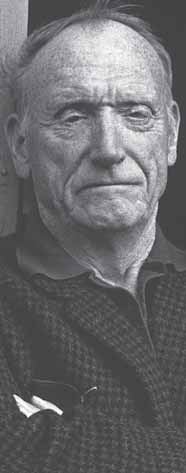
Robert Penn Warren
with the territory.”
(1905-1989)
Death of a Salesman, a landmark
Robert Penn Warren, one of the
work, still is only one of a number of
southern Fugitives, enjoyed a fruit-
dramas Miller wrote over several
ful career running through most of
decades, including All My Sons
the 20th century. He showed a life-
(1947) and The Crucible (1953).
long concern with democratic val-
Both are political — one contempo-
ues as they appeared within histor-
rary and the other set in colonial
ical context. The most enduring of
times. The first deals with a manu-
his novels is All the King’s Men
facturer who knowingly allows
(1946), focusing on the darker
defective parts to be shipped to air-
implications of the American
plane firms during World War II,
dream as revealed in this thinly
resulting in the death of several
veiled account of the career of a
American airmen. The Crucible
flamboyant and sinister southern
depicts the Salem (Massachusetts)
politician, Huey Long.
witchcraft trials of the 17th century
in which Puritan settlers were
Arthur Miller (1915-2005)
wrongfully executed as supposed
ew York-born dramatist
witches. Its message, though — that
Arthur Miller reached his
“witch hunts” directed at innocent
Npersonal pinnacle in 1949
people are anathema in a democracy
with Death of a Salesman, a study
— was relevant to the era in which
of man’s search for merit and
the play was staged, the early
worth in his life and the realization
1950s, when an anti-Communist cru-
that failure invariably looms. Set
sade led by U.S. Senator Joseph
within the family of the title charac-
McCarthy and others ruined the lives
ter, Willy Loman, the play hinges on
of innocent people. Partly in
the uneven relationships of father
response to The Crucible, Miller
and sons, husband and wife. It is a
was called before the House
mirror of the literary attitudes of
(of Representatives) Un-American
the 1940s, with its rich combination
Activities Committee in 1956 and
ROBERT PENN WARREN
of realism tinged with naturalism;
asked to provide the names of per-
carefully drawn, rounded charac-
sons who might have Communist
ters; and insistence on the value of
sympathies. Because of his refusal
the individual, despite failure and
to do so, Miller was charged with
error. Death of a Salesman is a
contempt of Congress, a charge
moving paean to the common man
that was overturned on appeal.
— to whom, as Willy Loman’s
A later Miller play, Incident at
widow eulogizes, “attention must
Vichy (1964), dealt with the
be paid.” Poignant and somber, it is
Holocaust — the destruction of
also a story of dreams. As one char-
much of European Jewry at the
acter notes ironically, “a salesman
hands of the Nazis and their collab-
has got to dream, boy. It comes
Photo © Nancy Crampton
orators. In The Price (1968), two
98

brothers struggle to free them-
were blacklisted (refused employ-
selves from the burdens of the
ment in the American entertain-
past. Other of Miller’s dramas
ment industry) for a time. These
include two one-act plays, Fame
events are recounted in Hellman’s
(1970) and The Reason Why (1970).
memoir, Scoundrel Time (1976).
His essays are collected in Echoes
Down the Corridor (2000); his auto-
Tennessee Williams
biography, Timebends: A Life,
(1911-1983)
appeared in 1987.
ennessee Williams, a native
of Mississippi, was one of the
T
Lillian Hellman (1906-1984)
more complex individuals on
Like Robert Penn Warren, Lillian
the American literary scene of the
Hellman’s moral vision was shaped
mid-20th century. His work focused
by the South. Her childhood was
on disturbed emotions within fami-
largely spent in New Orleans. Her
lies — most of them southern. He
compelling plays explore power’s
was known for incantatory repeti-
many guises and abuses. In The
tions, a poetic southern diction,
Children’s Hour (l934), a manipula-
weird gothic settings, and Freudian
tive girl destroys the lives of two
exploration of human emot









